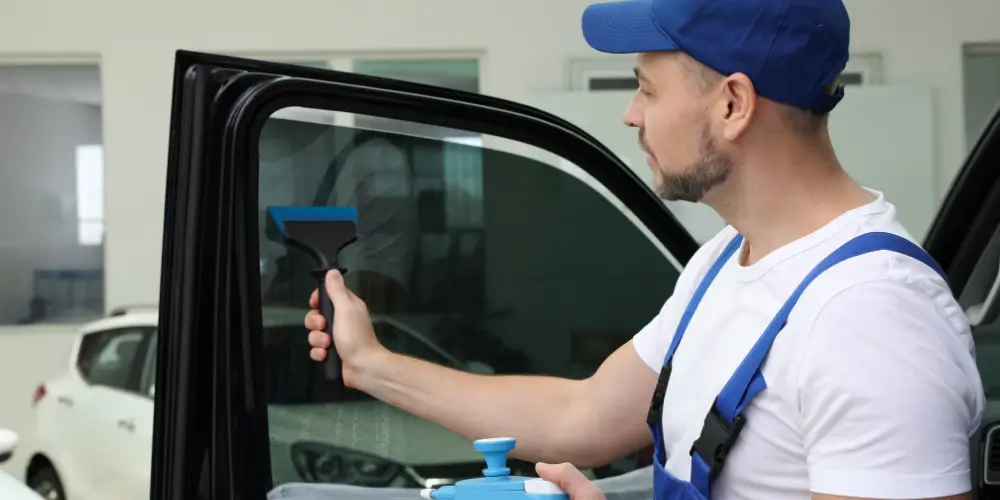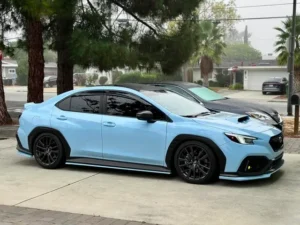Removing window tint glue can be a frustrating experience, especially if you’re not sure where to start and how do you remove window tint glue? You peel off the tint, only to find sticky residue clinging stubbornly to your windows. If you’ve ever attempted this task, you know that stubborn adhesive can can make window cleaning feel chanllenging. But fear not! Fortunately, you’re in the right place!
Many DIY lovers take pride in handling car maintenance themselves, but the challenge of removing window tint glue often leads to anxiety about damaging the glass or wasting time on ineffective methods. You’re not alone in feeling this way; countless individuals have faced similar hurdles when trying to achieve new surface their vehicle’s windows.

Our goal is to provide you with straightforward, actionable steps that will help you achieve a successful outcome without the difficulty. Join us as we explore various methods for removing window tint glue, from household items to specialized products. With clear tips, you’ll quickly change cloudy windows to crystal clear. Say goodbye to the stress and hello to a clearer view!
Table of Contents
ToggleWhat is Window Tint Glue & Formation?
Window tint glue is a specialized adhesive, sticky substance used to bond tinted films to glass surfaces, primarily in automotive like car windows and architectural applications like home windows.

How It Works?
The glue is designed to be very strong, which helps it hold the tinted film securely against the glass. When you apply window tint, the glue forms a bond with the glass surface, making it difficult for the film to peel off easily.
This glue ensures that the film stays in place strongly and provides benefits with staying against such as reducing heat and glare, offering privacy, and blocking harmful UV rays.
There are two main types of adhesives used in window tinting:
Dry Adhesive
This type is water-activated and allows for repositioning before final application. It is commonly used for flat glass surfaces, such as residential windows.
Sticky Adhesive
Also known as pressure-sensitive adhesive, tacky on application, ensures a strong hold on curved automotive windows in varying conditions.
Over time, sunlight’s UV rays can break down the adhesive, causing the tint to peel or bubble. This makes the glue brittle and less effective at sticking the film to the glass.
Layers of Window Tint Film
The window tint film itself is made up of several layers:
Top Layer: Protects the film from scratches and damage.
Tint Layer: This is the colored part that determines how dark or light the window will look.
Adhesive Layer: This is where the glue is found; it allows the film to stick to the glass.
Release Liner: A protective layer that keeps the adhesive safe until you’re ready to install it.
What Causes Glue That Held Tint on the Window?
Window tint glue used to bond tinted film to vehicle windows, and its effectiveness can be influenced by various factors over time.
Here are the primary causes of issues related to window tint glue:
Causes of Tint Glue Issues
Improper Surface Preparation
If the glass surface isn’t adequately cleaned or prepped before applying the tint, it can lead to air pockets or bubbles.
Incorrect Application Techniques
Inadequate installation methods, such as overstretching the film or trapping air during application, can result in bubbling and poor adhesion.
Environmental Factors
Sun Exposure
Extended UV exposure can weaken the adhesive bond over time, causing it to fail and leading to bubbling or peeling.
Humidity and Moisture
High humidity or moisture can seep under the film, further compromising the adhesive’s integrity.
Aging and Wear
Over time, old glue residue can fade visibility and attract dirt, making it essential to address any leftover adhesive when replacing or removing window film.
Why Removing Window Tint Glue is Difficult?
Removing window tint glue can be challenging due to several factors related to the adhesive properties and the materials involved.
Here are the primary reasons why this process is often difficult:
Strong Adhesive Strength & Composition
The adhesives used for window tinting are designed to be durable and resistant to environmental factors, which makes them difficult to remove once they have set. Older tints may use even stronger adhesives that have bonded more firmly over time.
Two-Layer Film Structure
Most window tint films consist of two layers. When attempting to peel off the film, the top layer may come off easily, but the second layer often remains stuck, flaking or tearing instead of peeling cleanly. This requires additional effort to remove the remaining adhesive without damaging the glass.
Environmental Factors
Heat and Time
The effectiveness of adhesive removal can be influenced by temperature. Heat is often used to soften the adhesive, but if not applied correctly, it can lead to uneven results or damage to the glass or tint film. Additionally, if the adhesive has been exposed to moisture or extreme temperatures, it may become more difficult to remove.
Residue and Cleanup
Sticky Residue
Even after removing the tint film, a sticky residue often remains on the glass. This residue can attract dirt and grime, complicating cleaning efforts and requiring additional solvents or scrubbing techniques to fully remove.
Chemical Resistance
Some adhesives are resistant to common solvents like ammonia or alcohol, making it necessary to use stronger chemicals or specialized adhesive removers that may not be readily available.
Fragile Tints
Older or damaged tints may fade during removal, leaving bits of film and glue stuck on the glass. This creates a patchy mess that requires extra effort to clean.
Tools & Techniques Matter
Without the right tools (e.g., heat gun, razor blade, adhesive remover) or knowledge of proper techniques, the process can become frustrating and inefficient.
To make the process easier, use a combination of heat (via a hairdryer or heat gun), soapy water, and an adhesive remover. Patience and the right approach can save time cost and prevent damage.
The combination of strong adhesives, a complex film structure, environmental influences, and stubborn residue contributes significantly to the difficulty of removing window tint glue.
Precautions Before Removing Tinted Window Film Glue
Proper preparation ensures a smooth and safe glue removal process. Keep these precautions in mind

Wear Protective Cover
Strong chemicals can irritate your skin or eyes.
Wear gloves and safety goggles when handling adhesive removers or rubbing alcohol.
Prepare for Cleanup
Adhesive and cleaning residue can be messy.
Keep extra microfiber cloths, paper towels, and a trash bag handy for easy cleanup.
Work in a Ventilated Area
Many adhesive removers contain strong chemicals that can produce harmful fumes.
Work outside or in a well-ventilated garage, keeping car doors and windows open
Testing and Application
Test a Small Area First
Before applying any adhesive remover or chemical solution to the entire window, test it on a small, inconspicuous area to check for potential damage to the glass or frame.
Soften the Glue
Apply heat using a heat gun or hairdryer, keeping it several inches away from the glass. This helps soften the glue, making it easier to remove without damaging the glass
Protect Surrounding Areas
Glue and cleaning solutions can drip onto car upholstery, door panels, or electronics, causing stains or damage and overspray.
Use painter’s tape, plastic sheets, or towels to cover nearby surfaces.
Removal Techniques
Use the Right Tools
Metal scrapers or rough tools can scratch the glass.
Opt for plastic scrapers, credit cards, or soft microfiber cloths.
Control Heat Application
Overheating can weaken the glass or damage window seals.
Use a hair dryer or heat gun on a low setting and keep it moving to avoid concentrating heat in one area.
Step-by-Step Guide: Cleaning Window Tint Glue
To effectively clean window tint glue, follow these detailed steps using various methods. Each method provides a systematic approach to ensure thorough removal of the adhesive residue left behind after removing window tint.
Popular Adhesive Removal Products
Grafix Gone
Specifically designed for film and vinyl adhesive removal. Best applied using a cloth for controlled scrubbing.
Goo Gone
Highly effective for general adhesive removal, followed by alcohol for residue cleanup.
91% Isopropyl Alcohol
Works well on most adhesives; apply with a paper towel or cloth.
Henry Adhesive Remover
Available at Home Depot; ideal when paired with a spray bottle for application.
Tools & Techniques
Razor Blade:
Essential for scraping off glue in layers. Ensure the blade is housed in a secure case for safety.
Heat Gun:
Softens the adhesive, making it easier to scrape or wipe off.
Newspaper or Microfiber Cloth:
Used with cleaning agents like vinegar or glass cleaner for a streak-free finish.
Additional Solvents
Ammonia:
Dissolves glue effectively; use in well-ventilated areas to avoid inhalation risks.
Brake Cleaner:
A last-resort option for stubborn adhesives. Handle with gloves to prevent skin irritation.
WD-40:
Works on adhesives; ensure thorough cleaning afterward to remove residue.
Alternative Methods for Stubborn Glue
When dealing with stubborn window tint glue, there are several effective alternative methods to consider. Here’s a breakdown of the most commonly recommended techniques:
Method 1: Using Ammonium or Vinegar
Prepare the Vinegar Solution
Fill a spray bottle with white vinegar solution.
Apply the Vinegar
Spray the vinegar directly onto the glue residue, ensuring it is well covered.
For added effectiveness, cover the area with paper towels soaked in vinegar.
Let It Soak
Allow the vinegar to sit for 10-15 minutes to soften the glue.
Clean the Area
After soaking, wash the area with warm, soapy water.
Use a plastic squeegee to gently scrape off the softened glue.
Final Rinse and Dry
Rinse with clean water and dry with a microfiber towel.
Repeat if necessary until all glue is removed.
Method 2: Using Rubbing Alcohol
Gather Materials
Obtain rubbing alcohol and a soft cloth.
Apply Rubbing Alcohol
Dip the cloth into rubbing alcohol and rub it in a circular motion over the glue residue.
Clean Up Residue
Wash the area with warm, soapy water to remove any remaining alcohol and glue.
Rinse and dry with a clean cloth.
Method 3: Soapy Water Method
This method utilizes soapy water to help loosen the adhesive.
Materials Needed
- Dish soap
- Water
- Spray bottle
- Plastic wrap
- Razor blade
Steps:
- Mix dish soap with water in a spray bottle and apply it to the inside of the window.
- Cover with plastic wrap to keep it moist
- Use heat from the sun or a hairdryer to warm up the area.
- Once softened, gently lift a corner with a razor blade and peel off the tint
Method 3: Using Heat (Steamer or Hair Dryer)
Prepare Your Tools
Use a steamer, hair dryer, or heat gun to warm the window surface.
Heat Application
Hold the heat source about 2-4 inches away from the window and move it in circular motions to avoid overheating any single spot.
Peel Off Tint
Once heated, carefully peel off the tint film from one corner, applying more heat as needed to loosen stubborn areas.
Remove Glue Residue
After removing the tint, use a scraper or cloth soaked in soapy water or adhesive remover to tackle any remaining glue.
Commercial Adhesive Removers
Specialized adhesive removers designed for automotive use can effectively break down window tint glue.
Materials Needed
Commercial adhesive remover and cloth.
Steps:
Apply according to product instructions, typically spraying it on and allowing it to sit before scraping off
- Always test any cleaning method on a small area first to ensure it does not damage your window.
- Avoid using razor blades directly on glass unless absolutely necessary; opt for plastic scrapers instead to prevent scratches
- If using commercial adhesive removers, follow product instructions for best results.
By following these methods, you can effectively clean window tint glue and restore clarity to your windows.
These methods provide various options depending on what materials you have available and your comfort level with each technique.
Common Mistakes to Avoid
Avoiding common mistakes when removing window tint can significantly enhance the effectiveness of the process and prevent damage to your windows.
Here are key pitfalls to watch out for:
- Patience is crucial when removing window tint. Heat it thoroughly and peel in sections to avoid damage or stubborn residue.
- Not applying enough heat makes adhesive hard to remove, while too much can damage the glass. Heat evenly with a hairdryer or heat gun.
- Proper preparation is crucial to avoid complications. Clean windows and free from dust or debris to prevent scratches during removal.
- After peeling off window tint, removing any leftover adhesive is crucial to maintain the window’s appearance and facilitate future tinting. Utilize solutions like ammonia or soapy water to dissolve the residual adhesive.
- Using dull blades or inappropriate scrapers can scratch or damage the glass. Always opt for sharp, clean tools designed for tint removal, and handle them carefully to avoid accidents.
- A common mistake is using ammonia without proper ventilation, which can expose you to harmful fumes. Ensure good ventilation for safer, smoother tint removal.
How to Prevent Glue Residue in the Future?
- Proper Installation of window Tint
- Choose high-quality tint films and products
- Focus on environmental factors
- Regular maintenance with gentle techniques and avoid too much scraping
- Use right tools and scratch removal techniques








